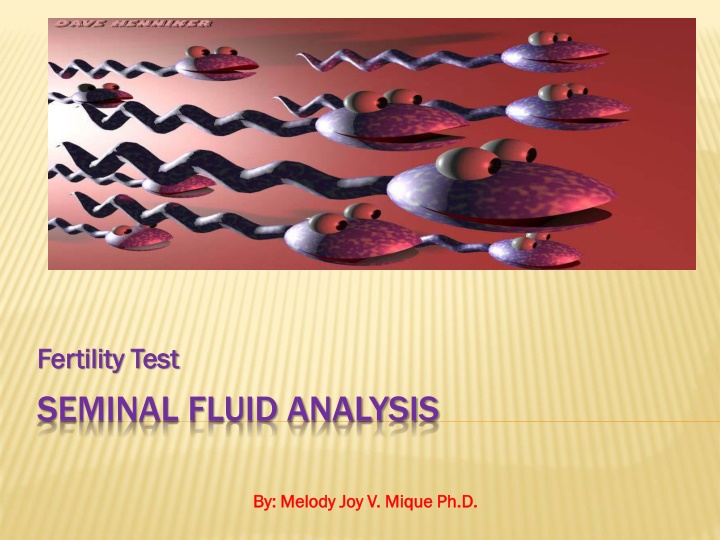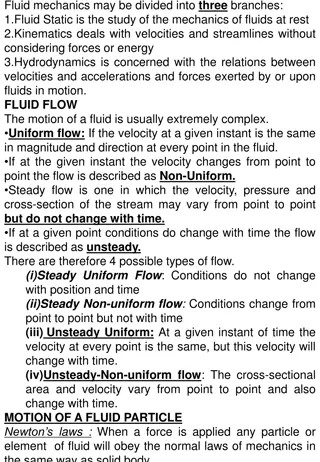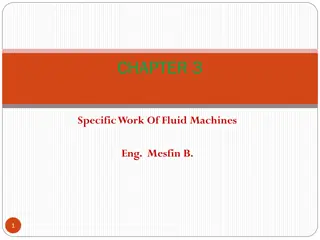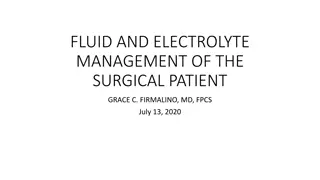
Seminal Fluid Analysis and Fertility Testing
Discover the importance of seminal fluid analysis, its composition, and reasons for conducting the test. Learn key terminologies related to fertility determination and sperm analysis methods.
Download Presentation

Please find below an Image/Link to download the presentation.
The content on the website is provided AS IS for your information and personal use only. It may not be sold, licensed, or shared on other websites without obtaining consent from the author. If you encounter any issues during the download, it is possible that the publisher has removed the file from their server.
You are allowed to download the files provided on this website for personal or commercial use, subject to the condition that they are used lawfully. All files are the property of their respective owners.
The content on the website is provided AS IS for your information and personal use only. It may not be sold, licensed, or shared on other websites without obtaining consent from the author.
E N D
Presentation Transcript
Fertility Test Fertility Test SEMINAL FLUID ANALYSIS By: Melody Joy V. Mique Ph.D. By: Melody Joy V. Mique Ph.D.
The seminal fluid is a composite solution containing basically of spermatozoa , suspended in seminal plasma made by seminal vesicle and accessory sex glands .
COMPOSITION OF A SEMINAL FLUID COMPOSITION OF A SEMINAL FLUID Spermatozoa Seminal Plasma Choline and spermin Fructose Proteolytic enzyme Prostatic secretion ACP and LDH
WHY IS IT DONE? 1. Fertility Determination. 2. Follow up of patients who have undergone vasectomy. 3. . For detection of future infertility due to radiotherapy and chemotherapy for cancer treatment . 4. For congenital abnormalities. 5. for MEDICOLEGAL purposes.
TERMINOLOGIES IMPORTANT TO REMEMBER TERMINOLOGIES IMPORTANT TO REMEMBER *ASPERMIA: *ASPERMIA:- - It is total absence of ejaculate. It is total absence of ejaculate. *AZOOSPERMIA: *AZOOSPERMIA:- - Absence of spermatozoa in semen. Absence of spermatozoa in semen. *OLIGOZOOSPERMIA: *OLIGOZOOSPERMIA:- - It is reduction in volume of It is reduction in volume of ejaculate and total sperm count less than 20 million ejaculate and total sperm count less than 20 million cells/ml. cells/ml. ASTHENOZOOSPERMIA: ASTHENOZOOSPERMIA:- - Characterizes by spermatozoa Characterizes by spermatozoa less than 50% actively motile.(category {a} and {b} ). less than 50% actively motile.(category {a} and {b} ). TERATOZOOSPERMIA: TERATOZOOSPERMIA:- - 50% spermatozoa with normal 50% spermatozoa with normal morphology. morphology. HYPERSPERMIA: HYPERSPERMIA:- - Increase in semen volume and count Increase in semen volume and count more than 300 million/ml. more than 300 million/ml. NECROSPERMIA: NECROSPERMIA:- - Normal count of sperm but non motile Normal count of sperm but non motile spermatozoa. spermatozoa. HAEMOSPERMIA: HAEMOSPERMIA:- - Plenty of RBC and pus cells in se Plenty of RBC and pus cells in semen. men.
Sperm Analysis for Fertility Determination Sperm Analysis for Fertility Determination A. Method of Collection A. Method of Collection * There should be 1 week abstinence * There should be 1 week abstinence 1. Masturbation 1. Masturbation 2. Coitus interruptus 2. Coitus interruptus 3. Vaginal Vault aspiration 3. Vaginal Vault aspiration 4. Condom method(less commonly used) 4. Condom method(less commonly used) B. Preservation B. Preservation: : It must be kept same with the body temperature at 370C (under axial) Transit of specimen= within 20-30 minutes MEDICOLEGAL purposes MEDICOLEGAL purposes. . Collected as stain from anything in the crime scene Collected as stain from anything in the crime scene and also vaginal vault aspiration from rape victims and also vaginal vault aspiration from rape victims
SEMINAL FLUID EXAMINATION A. Physical Examination/Gross Examination B. Chemical Examination C. Microscopic Examination
A. PHYSICAL EXAMINATION A. PHYSICAL EXAMINATION 1. 1. Amount or volume Amount or volume: Normal Value = 1.5 to 5 ml per : Normal Value = 1.5 to 5 ml per ejaculation ejaculation Less volume may be due to non Less volume may be due to non- -abstinence. 2. 2. Color /Appearance Color /Appearance: : Opaque Gray or pearly white Opaque Gray or pearly white to light yellow to light yellow Extended abstinence will affect its color Extended abstinence will affect its color Color may change due to:- (a)Presence of urine:- May be present in man with disturbances of bladder neck function and ejaculation. A high urea content may confirm presence of urine abstinence.
(b)Presence of blood:- Traces of fresh blood imparts pink color to semen. Larger amounts imparts brighter color to semen. (c)Presence of bilirubin:- Presence of bilirubin may impart yellow color to semen just as it dose to other body fluids. LIQUIFICATION TEST:- Normal :- 20-30 min. Generally the semen coagulates after coming out and liquefy due to activity of enzymes secreted from prostate gland on fibrinogen like precursor secreted by seminal vesicle. It is assessed visually.
3. Odor 3. Odor: distinct; spermatic; Clorox like; acrid odor; fishy pungent sweet odor. It may change due to bacterial growth. 4. Viscosity 4. Viscosity: Freshly Ejaculated= highly viscid/creamy gelatinous/thick, mucoid > Absence of this characteristic: Low cell count >It is measures using a pasture pipette. If drop by drop falls viscosity is normal > Self liquidation happens within 10-30 minutes after ejaculation because of fibrinolysis > The liquefaction releases the sperm cell. Delayed liquefaction= abnormal
5. Reaction 5. Reaction: >alkaline with Ph 7.2-8.0; average of 7.8 >Becomes slightly alkaline on standing at R.T. >May be slightly acidic in APLASIA of vas deferens and seminal vesicle. 6. Specific Gravity 6. Specific Gravity: 1.033
B. CHEMICAL EXAMINATION B. CHEMICAL EXAMINATION * * Determination of the Presence of Determination of the Presence of FRUCTOSE Fructose = Main carbohydrate supplying energy for the movement of spermatozoa. Present in high concentration in seminal plasma secreted by seminal vesicle. Normal:-150-300mg/dl FRUCTOSE:- Decreased condition:- 1>T.B of seminal vesicle. 2>Androgen deficiency. 3>Testosterone therapy. 4>Obstruction of ejaculatory duct.
PROCEDURE:- 1. Resorcinol Method 1. Resorcinol Method 5ml resorcinol reagent + 0.5 ml semen __ HEAT __ Result = Orange red precipitate REAGENT:- resorcinol :-50 mg Con.HCl :- 33 ml D/W :- 100 ml water 2. Condensation with Indole Glacial Acetic acid 2. Condensation with Indole Glacial Acetic acid Measured in spectrophotometer Measured in spectrophotometer, , Result: giving a purple Colored compound Result: giving a purple Colored compound *Diminish level of Fructose: parallel androgen *Diminish level of Fructose: parallel androgen Deficiency Deficiency *Relationship between fructose and sperm count: *Relationship between fructose and sperm count: Directly Proportional Directly Proportional Low fructose: low testosterone level Low fructose: low testosterone level
C. MICROSCOPIC EXAMINATION 1. Motility Test and Confirmatory Test 2. Sperm Count 3. Sperm Morphology
C. MICROSCOPIC EXAMINATION 1. Motility Test 1. Motility Test Motility of spermatozoa is important in the penetration of the Motility of spermatozoa is important in the penetration of the Cervical mucus and subsequently migrate to penetrate the ovum. Cervical mucus and subsequently migrate to penetrate the ovum. *Complete Liquefaction of the seminal fluid is necessary to *Complete Liquefaction of the seminal fluid is necessary to observe full motility of spermatozoa observe full motility of spermatozoa *Normal Movement of Sperm: Progressive *Normal Movement of Sperm: Progressive Factors affecting Motility: Factors affecting Motility: 1.liquifaction of the seminal fluid 1.liquifaction of the seminal fluid 2. Temperature 2. Temperature 3. Period of Abstinence 3. Period of Abstinence 4. Manner of collection 4. Manner of collection 5. Types of movement of the spermatozoa 5. Types of movement of the spermatozoa 6. The number of sperm cell present 6. The number of sperm cell present
METHOD: METHOD:- - Place a drop of liquefied semen on glass slide and cover with Place a drop of liquefied semen on glass slide and cover with cover slip. cover slip. Examine in low power & high dry power objective using low Examine in low power & high dry power objective using low light by adjusting diaphragm. light by adjusting diaphragm. Grading For Motility Observation: Grading For Motility Observation:- - Grade 0: Grade 0:- - Non Non- -motile Grade 1: Grade 1:- - sluggish forward progression sluggish forward progression Grade 2: Grade 2:- - Defining forward Defining forward Grade 3: Grade 3:- - Good forward movement Good forward movement Grade 4: Grade 4:- - Vigorous and rapid forward progression Vigorous and rapid forward progression motile Check motility after 2,4,6 hrs interval. Check motility after 2,4,6 hrs interval.
Confirmatory Test for Motility Test: Confirmatory Test for Motility Test: Perform Blooms Test Perform Blooms Test Principle/Result: Dead sperm cells absorb the Principle/Result: Dead sperm cells absorb the stain thus appears to be red while alive sperm stain thus appears to be red while alive sperm cells resists the stain. cells resists the stain.
2. Sperm Count:- Normal:- 40-300 million cells/cumm Oligospermia:- Decreased sperm count;due to Suppression of endogenous gonadotropin Estrogen secreting tumor Hypo & hyper thyroidism Mumps leprosy Irradiation orchitis (Inflamation of the testes) Hypopituitarism Varioceles Hypogonadism
Azoospermia:- absence of spermatozoa in the semen Ductal obstruction Klinefelter syndrome Sertoli cell syndrome Post mumps Polyspermia= increased sperm count:- more than 300 million cells / cumm, results in infertility.
Procedure sperm Counting Needed: Diluting fluid, Counting chamber, WBC pipette Microscope SEMEN DILUTING FLUID:-NaHCo3= 5 gm, Formalin neutral= 1 ml D/W = 100 ml Draw semen upto 0.5 mark in WBC pipette. Draw semen diluting fluid (Used to immobilize sperm and preserve them) upto 11 mark & mix well. Load it in improved Neubauer counting chamber & allow to settle for 5 min then view it under the microscope Count the sperm in four end W square. Count only those that are inside the square, do not include those at the borderline
CALCULATION:- Sperm cell/ml= TCSCx10x40x1000 4 TCSC= total count of sperm cell Normal Value: 60-150 million sperm cell
3. Morphological Examination: 3. Morphological Examination: The morphology of the sperm cell is seen in a stained preparation Normal Morphology of the Sperm Cell Normal Morphology of the Sperm Cell Head Head = = relatively large, flattened ; relatively large, flattened ; 3 3- -6 micron in length and 6 micron in length and 2 2- -3 micron in width, 3 micron in width, uniform in size and shape uniform in size and shape Midpoint or neck Midpoint or neck = = a small connecting piece a small connecting piece between the head and the tail between the head and the tail Tail Tail = = a long slender part that exhibit s a violent a long slender part that exhibit s a violent whip whip- -like Motion like Motion
Abnormal Morphology of the Sperm Cell Abnormal Morphology of the Sperm Cell Head Head = too large and too small, absent, double, too large and too small, absent, double, abnormal shape, atypical distribution of the abnormal shape, atypical distribution of the chromatin, swollen, irregular, pointed, ragged chromatin, swollen, irregular, pointed, ragged edge and vacuoles edge and vacuoles Midpoint or neck Midpoint or neck = absent, swollen, rudimentary, = absent, swollen, rudimentary, bifurcated bifurcated Tail Tail = rudimentary, absent, doubled, swollen and = rudimentary, absent, doubled, swollen and too short too short
STAINED PREPARATION Procedure: 1. After liquefaction, make a thin smear of semen on a glass slide just as blood film is prepared. 2. Let it air dry & heat gently for fixation. 3. If necessary remove mucus by dipping the smear in semen diluting fluid. 4. Staining could either be done by Leishman staining, Papanicolau stain or carbol fuschin staining method.
OBSERVATION:- Head= light blue Vacuoles= Dark blue Body & tail= pinkish or red.






















